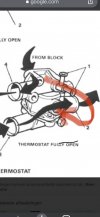Mxgrds
True Classic
My X Uno turbo’s coolwater gets pretty hot when driving 120km/h on the highway for some time. I posted that in a group on facebook and someone suggested to block the thermostat outlet to the tank in order to force that flow to go also to the rad for better cooling. I looked carefull to the thermostat and found that the in- and outlet are almost in the same chamber of the thermostat. So the overpressure will found it’s way through the inlet at the bottom of the tank. In my case the turbo cooling is now using the inlet on the top of the tank.
What do tou think? Usefull? Or does it just mean that the faster rad flow, cools down less?
What do tou think? Usefull? Or does it just mean that the faster rad flow, cools down less?

